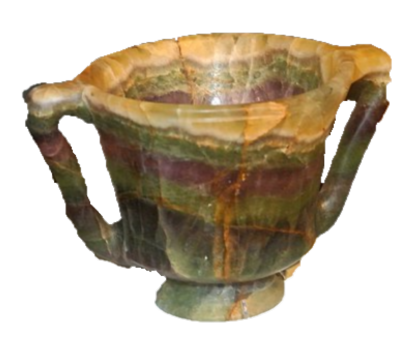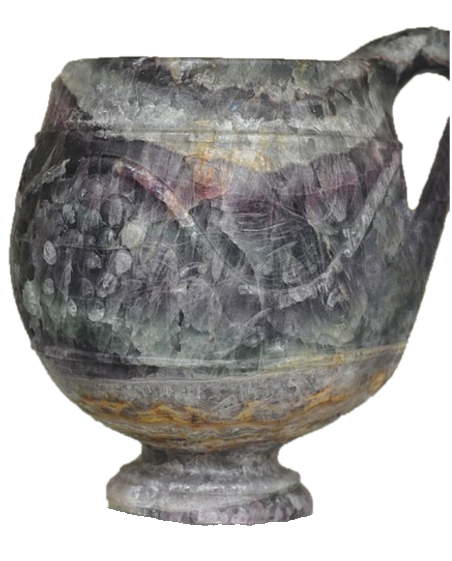
Fluorite is a calcium crystal which forms in bands, often of multiple colours. The colours are mostly greens and purples but also pink, yellow and blue. The rarest being the pink. However, it can also change colour in different types of light.
Fluorite typically glows a blue-violet colour under ultraviolet light some glow a cream or white colour whilst others do not fluoresce at all. Fluorescence in fluorite is thought to be caused when trace amounts of yttrium, europium, samarium, or other elements substitute for calcium in the fluorite mineral structure.
When sold in bulk Fluorite is called Fluorspar, and sold in three different grades (acid, ceramic, and metallurgical). Whilst having a wide range of different colours some has its own very unusual property:
Antozonite: Fluorite with the element fluorine incorporated in it. Known for its unpleasant smell when it is crushed because fluorine reacts to oxygen and water vapour to produce ozone.
Blue John: Only found in one small part of the UK. The mineral has bands of blue, purple, and yellow colours.
Chlorophane: This rare mineral has the property of thermoluminescence, meaning that it emits visible light when heated even from the heat of someone’s hand while they hold it.
Fluorite historical use and lore
The Chinese used the scarlet fluorite as a protection against bad spirits. Green fluorite would be a substitute for jade in stone sculptures.
The Egyptians would use fluorite to carve pearls, scarabs and other religious artefacts.
The Romans believed drinking alcohol from a carved fluorite glass prevented drunkenness. Archaeologists discovered fluorine-based objects in the ruins of Pompeii.
Persian miners likely extracted fluorite for Murrine drinking cups. When used for wine, the stone imparted a strange yet pleasant taste, influenced by residual myrrh resin applied during carving to prevent shattering.
Roman historian Pliny the Elder recorded that vasa murrina arrived in Rome with Pompey the Great in 62–1 BCE after his Eastern conquests. Demand soared—Pliny noted that Emperor Nero paid 1,000,000 sesterces for a fluorspar cup, while a former consul spent 70,000 sesterces on one. His attachment was so strong that he reportedly gnawed its rim.
The British Museum holds two renowned Roman fluorite drinking cups: the Barber Cup and the Crawford Cup.


The Romans excavated the famous “Blue John,” a striking blue-yellow fluorite. People regularly linked the Latin word murra with the mineral fluorspar.
During the Middle Ages, people referred to Fluorite as the “ore flower.”
Murrino glass
Murrine (murrina) and Murrino glass have ancient origins, with the first works emerging between 3,000 and 2,000 BCE, crafted by Syrian, Egyptian, and Roman glassmakers. Romans identified “Murrino” as mosaic glass vases and bowls made from coloured cane sections featuring patterns or images. Cutting the cane into thin cross-sections revealed designs such as faces, flowers, and animals. Craftsmen created these vases from murrha, a material containing Fluorite, which produced a distinctive scent—possibly from binding resins or because they held perfumes.
During the Middle Ages, artisans lost the murrino glass technique but revived it in the late 19th century.
Healing
Fluorite is known for its healing properties of cleansing and stabilising the aura Neutralising negative energies and stress in the body. Because it can help people concentrate and organise things, It is a good stone for students and creative people whom struggle with order and structure. Similarly, it is good for clarity, mental enhancement concentration, self-confidence, and decision-making. Fluorite will allow the mind to flow freely to balance thoughts and ideas.
Highly recommended for people who have trouble navigating life by assisting in making the decisions you genuinely want. It is an important stone for Libras and can better their confidence, especially when it comes to important decisions that affect the future.
Fluorite varieties
There are many colours of Fluorite, each with its own unique effect on users.
Pink Opens up the heart and assists in self-love and healing.
Black The ultimate cleanser and purifier of negativity. Its energies serve as a shield around your emotional body.
Purple For spiritual balance as it attunes the mind with higher vibrations and enables the ability to ascend our spirit and consciousness.
Blue Calms emotions and helps communicate ideas. Ideal for teachers, speakers, artists etc.
Colourless is an intuitive stone and activate the third eye leading to enhanced psychic abilities.
Green Fluorite connects our heart and mind together bringing a balance between emotion and thought. It can bring hormones into balance as well as harmonising the chakras.
Yellow shares a sacred connection between the solar plexus and third eye chakra. This bond creates a pathway towards self-expression to enhance creativity, as well as for calming the mind.
